On the stereochemical course of palladium-catalyzed cross-coupling of allylic silanolate salts with aromatic bromides
- PMID: 20163185
- PMCID: PMC2836786
- DOI: 10.1021/ja910804u
On the stereochemical course of palladium-catalyzed cross-coupling of allylic silanolate salts with aromatic bromides
Abstract
The stereochemical course of palladium-catalyzed cross-coupling reactions of an enantioenriched, alpha-substituted, allylic silanolate salt with aromatic bromides has been investigated. The allylic silanolate salt was prepared in high geometrical (Z/E, 94:6) and high enantiomeric (94:6 er) purity by a copper-catalyzed S(N)2' reaction of a resolved allylic carbamate. Eight different aromatic bromides underwent cross-coupling with excellent constitutional site-selectivity and excellent stereospecificity. Stereochemical correlation established that the transmetalation event proceeds through a syn S(E)' mechanism which is interpreted in terms of an intramolecular delivery of the arylpalladium electrophile through a key intermediate that contains a discrete Si-O-Pd linkage.
Figures
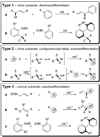


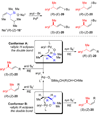
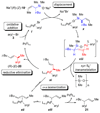

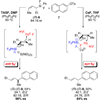


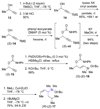


Similar articles
-
Mechanistic significance of the si-o-pd bond in the palladium-catalyzed cross-coupling reactions of arylsilanolates.J Am Chem Soc. 2015 May 20;137(19):6200-18. doi: 10.1021/jacs.5b02518. Epub 2015 May 6. J Am Chem Soc. 2015. PMID: 25945516 Free PMC article.
-
Palladium-catalyzed cross-coupling reactions of organosilanols and their salts: practical alternatives to boron- and tin-based methods.Acc Chem Res. 2008 Nov 18;41(11):1486-99. doi: 10.1021/ar800037p. Acc Chem Res. 2008. PMID: 18681465 Free PMC article.
-
γ-Selective cross-coupling of allylic silanolate salts with aromatic bromides using trialkylphosphonium tetrafluoroborate salts prepared directly from phosphine•borane adducts.Org Lett. 2011 Sep 2;13(17):4596-9. doi: 10.1021/ol2017998. Epub 2011 Aug 10. Org Lett. 2011. PMID: 21830766 Free PMC article.
-
Mechanistic duality in palladium-catalyzed cross-coupling reactions of aryldimethylsilanolates. intermediacy of an 8-Si-4 arylpalladium(II) silanolate.J Am Chem Soc. 2010 Feb 3;132(4):1243-5. doi: 10.1021/ja907049y. J Am Chem Soc. 2010. PMID: 20058920 Free PMC article.
-
Synthesis of Enantioenriched Allylic Silanes via Nickel-Catalyzed Reductive Cross-Coupling.J Am Chem Soc. 2018 Jan 10;140(1):139-142. doi: 10.1021/jacs.7b11707. Epub 2017 Dec 20. J Am Chem Soc. 2018. PMID: 29202243 Free PMC article.
Cited by
-
Congested C-C bonds by Pd-catalyzed enantioselective allyl-allyl cross-coupling, a mechanism-guided solution.J Am Chem Soc. 2014 May 14;136(19):7092-100. doi: 10.1021/ja502280w. Epub 2014 Apr 29. J Am Chem Soc. 2014. PMID: 24720611 Free PMC article.
-
Highly Enantioselective Hiyama Cross-Coupling via Rh-Catalyzed Allylic Arylation of Racemic Allyl Chlorides.Organometallics. 2019 Oct 28;38(20):3991-3995. doi: 10.1021/acs.organomet.9b00197. Epub 2019 May 10. Organometallics. 2019. PMID: 32055086 Free PMC article.
-
Ligand-controlled palladium-catalyzed regiodivergent Suzuki-Miyaura cross-coupling of allylboronates and aryl halides.J Am Chem Soc. 2013 Jul 24;135(29):10642-5. doi: 10.1021/ja405950c. Epub 2013 Jul 12. J Am Chem Soc. 2013. PMID: 23837686 Free PMC article.
-
10-Step Asymmetric Total Synthesis and Stereochemical Elucidation of (+)-Dragmacidin D.Angew Chem Int Ed Engl. 2015 Aug 17;54(34):9971-5. doi: 10.1002/anie.201504113. Epub 2015 Jun 30. Angew Chem Int Ed Engl. 2015. PMID: 26130270 Free PMC article.
-
Switching Selectivity in Borylative Allyl-Allyl Cross-Coupling through Synergistic Catalysis.J Am Chem Soc. 2024 Aug 7;146(31):21977-21988. doi: 10.1021/jacs.4c07188. Epub 2024 Jul 24. J Am Chem Soc. 2024. PMID: 39046799 Free PMC article.
References
-
- de Meijere A, Diederich F, editors. Metal-Catalyzed Cross-Coupling Reactions. Second Ed. Weinheim: Wiley-VCH; 2004.
- Negishi E-I, editor. Handbook of Organopalladium Chemistry for Organic Synthesis. New York: Wiley–Interscience; 2002.
-
- Ojima I, editor. Catalytic Asymmetric Synthesis. Second Ed. New York: Wiley–VCH; 2000.
- Tietze LF, Ila H, Bell HP. Chem. Rev. 2004;104:3453–3516. - PubMed
- Hayashi TJ. Organomet. Chem. 2002;653:41–45.
- Hayashi T. Chapt. 25. In: Jacobsen EN, Pfaltz A, Yamamoto H, editors. Comprehensive Asymmetric Catalysis. Vol. II. Heidelberg: Springer Verlag; 1999.
- Blystone SL. Chem. Rev. 1989;89:1663–1679.
-
-
The trivial case of cross-coupling of chiral subunits where the newly formed carbon–carbon bond is not a stereogenic unit are excluded.
-
-
-
By far the largest category of transition metal-catalyzed, carbon-carbon and carbon-heteroatom bond forming reactions involves the asymmetric capture of π-allyl-metals derived from palladium, molybdenum, rhodium and iridium with a wide range of nucleophiles. These powerful reactions have been thoroughly reviewed and therefore will not be categorized here, see: Lu Z, Ma S. Angew. Chem., Int. Ed. 2008;47:258–297. Trost BM, Crawley ML. Chem. Rev. 2003:2921–2943. Pfaltz A, Lautens M. Chapt. 24. In: Jacobsen EN, Pfaltz A, Yamamoto H, editors. Comprehensive Asymmetric Catalysis. Vol. II. Heidelberg: Springer Verlag; 1999.
-
-
-
For a definition of internal and external selection see: Denmark SE, Almstead NG. Allylation of Carbonyls: Methodology and Stereochemistry. In: Otera J, editor. Modern Carbonyl Chemistry. Weinheim: Wiley–VCH; 2000. pp. 299–402.
-
Publication types
MeSH terms
Substances
Grants and funding
LinkOut - more resources
Full Text Sources
Other Literature Sources
Miscellaneous

